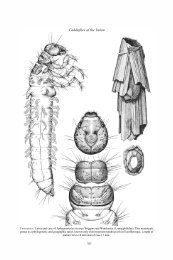No. 9 1998 ARC TIC IN SECT NEWS - Department of Biological ...
No. 9 1998 ARC TIC IN SECT NEWS - Department of Biological ...
No. 9 1998 ARC TIC IN SECT NEWS - Department of Biological ...
You also want an ePaper? Increase the reach of your titles
YUMPU automatically turns print PDFs into web optimized ePapers that Google loves.
6 <strong>ARC</strong><strong>TIC</strong> <strong>IN</strong><strong>SECT</strong> <strong>NEWS</strong> <strong>No</strong>. 9, <strong>1998</strong><br />
ing to the snow-covered Lowland. Mites<br />
were ubiquitous and the fauna should en -<br />
compass more than the 22 identified spe -<br />
cies, 7 <strong>of</strong> which are par a sitic.<br />
Eight orders <strong>of</strong> insects were represented by<br />
156 identified species on the Lowland. These<br />
included sev eral species <strong>of</strong> lice from birds, and<br />
one from a walrus. The true diversity <strong>of</strong> lice will<br />
be greater, but is inherently difficult to as sess as<br />
it requires killing and combing vertebrate hosts.<br />
One homopteran species, a male scale, was col -<br />
lected on a sin gle oc ca sion. Aphids were<br />
sought, but not found. Such sea sonal ae rial<br />
plankton mi grants might colonize in the future.<br />
One caddisfly species was collected an nu ally<br />
from the shores <strong>of</strong> several lakes. Of the three<br />
bee tle spe cies, the pond dwell ing dytiscid<br />
Hydroporus po laris and the carabid<br />
Amara alpina were frequently encoun -<br />
tered, while the 2.5 mm staphylinid<br />
Gynpeta sp. was rare. Four or ders,<br />
Collembola, Lepidoptera, Diptera and<br />
Hymenoptera, dom i nated the in sect<br />
fauna.<br />
Collembola populations and their effects on<br />
soil metabolism were studied intensively by<br />
Addison (in Bliss 1977). Moulting by adults,<br />
and long adult lives, compounded population<br />
anal y ses, but spe cific fo cus on abun dant<br />
Hypogastura tullbergi produced clearer<br />
un der stand ing <strong>of</strong> the sig nif i cance <strong>of</strong><br />
these insects. Thirty species were cited in<br />
the IBP list. Fjellberg (1986) made eight<br />
revisions to this list, including the sig nif -<br />
icant change <strong>of</strong> H. tullbergi to H. concolor<br />
(Carpenter 1900). Other stud ies are re -<br />
ported by Babenko (1994).<br />
Lepidoptera taxa in cluded two but ter fly<br />
species and 12 moths. Both Boloria but ter -<br />
flies were melanized, a condition that has<br />
been noted to aid solar basking by arctic<br />
insects. Because but ter flies are at trac -<br />
tive to col lec tors, the di ver sity <strong>of</strong> but ter -<br />
flies <strong>of</strong>fers a simple scale to compare di -<br />
ver sity <strong>of</strong> insect faunas at other lo ca -<br />
tions. Gynaephora moths, investigated in<br />
detail as models for the study <strong>of</strong> polar ad -<br />
ap ta tion and en ergy flow (Ryan and<br />
Hergert, in Bliss 1977), remain a focus <strong>of</strong><br />
continued study by Olga Kukal and oth -<br />
ers. Larvae <strong>of</strong> the two Olethreutes moth<br />
species have subsequently received at -<br />
tention from Sharron Meier as min ers<br />
within hollow Pedicularis stems.<br />
Flies comprised the most visibly abundant<br />
group <strong>of</strong> insects at Truelove. The so viet IBP en -<br />
to mol o gist Yuri Chernov vis ited the site in<br />
1989 and es ti mated that he collected 8 spe cies<br />
<strong>of</strong> tipulid flies, versus 4 cited in the appendix.<br />
He thought that the single syrphid species prob -<br />
ably belongs in the genus Platycheirus, and<br />
is not Melanostoma n. sp. Chironomid<br />
flies, the species diversity <strong>of</strong> which is ex -<br />
pected to be greater than the 21 species<br />
indicated in the appendix, emerge from<br />
lakes in great abun dance. They were<br />
noted to be a source <strong>of</strong> nitrogen enrich -<br />
ment to meadows adjacent to lakes. Don<br />
Pattie observed two arctic foxes eat ing<br />
windrows <strong>of</strong> lake-edge chironomids, and<br />
their scats revealed distinct evidence <strong>of</strong><br />
gnat con sump tion. The two Aedes sp.<br />
mosquitoes were uncommon during the<br />
1970-74 period. Their pestiferous times,<br />
when per haps 20 mos qui toes an noyed<br />
each researcher even at 320 m a.s.l. on<br />
the plateau, lasted about 10 days. Indi -<br />
vid uals fre quently flew away with out<br />
feed ing. As an other an ec dote about<br />
Truelove conditions, a car cass <strong>of</strong> a win -<br />
ter-killed musk ox calf was colonized by<br />
calliphorid fly larvae in the summer <strong>of</strong><br />
1971. Most <strong>of</strong> these lar vae were unable to<br />
complete development that sum mer, and<br />
were eaten by arctic foxes be fore the next<br />
spring.<br />
The Hymenoptera species list remains un -<br />
changed from the 1977 ap pen dix, al though<br />
Bombus hyperboreus is expected to be<br />
found. Kukal and Pattie (1988) witnessed<br />
two events <strong>of</strong> snow bunting nests be ing<br />
usurped by B. po laris, forcing these birds<br />
to aban don their eggs.<br />
The fauna was found to in clude no molluscs<br />
(ex cept ma rine molluscs), nor any<br />
orthopteroids, aphids, thrips and neuropteroid<br />
insects. The largest insects were lymantriid and<br />
noc tu id moths, bumble bees and tipulid flies.
















